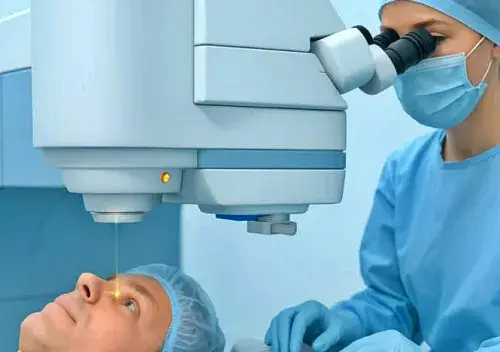Correcting Vision. A life without glasses or contact lenses is a dream for many, and for decades, laser-assisted (LASIK) has been the most popular way to make that dream a reality.
Millions of people worldwide have opted for this procedure, which uses a laser to reshape the cornea and correct common vision problems like nearsightedness, farsightedness, and astigmatism. It’s a fast, precise, and effective method.
Correcting Vision and LASIK.
But despite its success, LASIK isn’t the perfect solution for everyone. It’s an invasive surgical procedure that involves permanently removing a small amount of corneal tissue.
This can lead to certain risks and side effects, such as dry eyes, discomfort, and, in rare cases, a weakening of the cornea’s structure.
Furthermore, the procedure isn’t suitable for all patients.
People with thin corneas, certain medical conditions like keratoconus or uncontrolled diabetes, and those with some autoimmune diseases are often not candidates.
Even age can be a limiting factor, as the procedure is typically only recommended for people over 18 whose eyes have fully developed.
This raises an important question, what if there was a way to correct vision without a laser, without surgery, and without permanently altering the eye’s structure?
Correcting Vision a nd Big Revolution.
The Promise of Electromechanical Remodeling (EMR).
A team of researchers led by chemist Michael Hill from Occidental College and surgeon Brian Wong from the University of California, Irvine, may have found a groundbreaking alternative.
They’ve developed a completely new approach called electromechanical remodeling (EMR), which can correct the shape of the cornea using a mild electric current.
This method is based on a fascinating scientific principle: the collagen fibers that make up the cornea, as well as many other tissues in the body, can be temporarily made pliable using electricity.
Under normal circumstances, these fibers are held in a rigid structure by the attraction of oppositely charged molecules, much like tiny magnets.
By applying a carefully calibrated electric current, the researchers found they could temporarily change the acidity of the surrounding tissue, which weakens these bonds. When the bonds loosen, the tissue becomes soft and moldable.
Once the tissue is pliable, it can be reshaped. In the case of vision correction, the researchers developed a special platinum “contact lens” that acts as a template. The lens is placed on the eye, and the electric current is applied for just a minute.
The cornea molds itself to the new shape of the template. When the current is turned off, the acidity returns to normal, and the collagen bonds lock the cornea into its new, corrected shape.
EMR vs. LASIK.
A New Paradigm.
EMR represents a fundamental shift away from the traditional model of laser surgery. While LASIK works by “carving” or ablating tissue, EMR simply reshapes what is already there. This distinction is crucial, as it offers several significant advantages:
• No Tissue Removal: Since no corneal tissue is removed, the structural integrity of the eye remains intact. This could make EMR a safer option for people with thin corneas or other conditions that would disqualify them from LASIK.
• A Less Invasive Procedure: Unlike LASIK, which requires creating a flap in the cornea, EMR is non-invasive. This eliminates many of the associated risks and potential side effects.
• Potential for Reversibility: Because the tissue is not removed, but rather “reconfigured,” the process may be reversible in the future, if needed. This is not possible with traditional laser surgery.
• Broader Applications: The EMR method may have applications far beyond correcting refractive errors. The research team believes it could also be used to treat corneal opacities (clouding of the cornea), a condition currently treated with a corneal transplant.
• More Affordable and Accessible: The equipment required for EMR is expected to be much less expensive than the advanced laser systems used for LASIK. This could make vision correction more widely available to a larger population around the world.
The Road Ahead.
So, when can we expect this revolutionary new procedure to be available? The answer is not so simple. While the initial results on ex vivo (isolated) animal eyes are incredibly promising, there’s a long and rigorous path ahead before EMR can be approved for human use.
The next steps for the research team will involve:
• In Vivo Testing: Conducting long-term studies on live animals to ensure the procedure is safe, effective, and that the corrected vision is stable over time.
• Expanding Applications: Investigating which specific refractive errors—myopia, hyperopia, and astigmatism—can be successfully corrected with EMR.
• Clinical Trials: Once preclinical studies are complete, the technology will need to go through multiple phases of human clinical trials to confirm its safety and efficacy.
Despite the long road, the scientific community is cautiously optimistic. EMR is an elegant and gentle approach that avoids heating or damaging tissues, making it a potentially safer alternative to current procedures.
With its promise of affordability and broader applicability, this new method of vision correction could truly change the lives of millions. What do you think about a laser-free, non-invasive method for correcting vision?
Have a Great Day!




